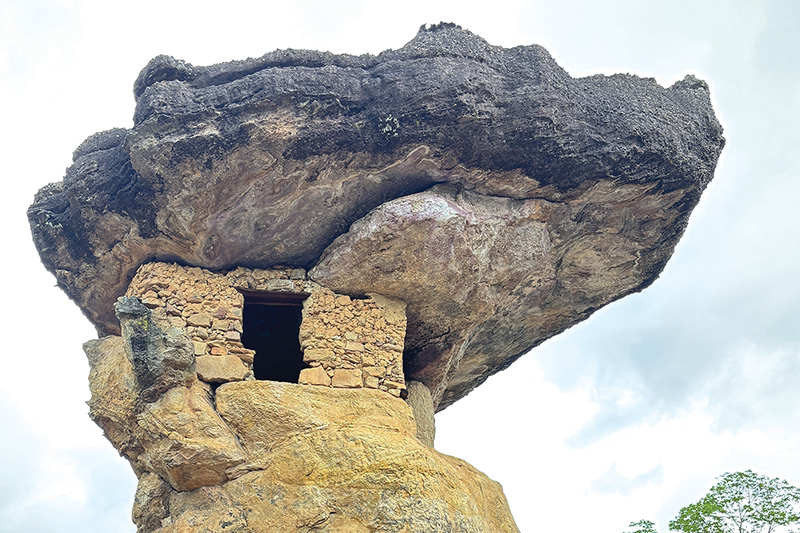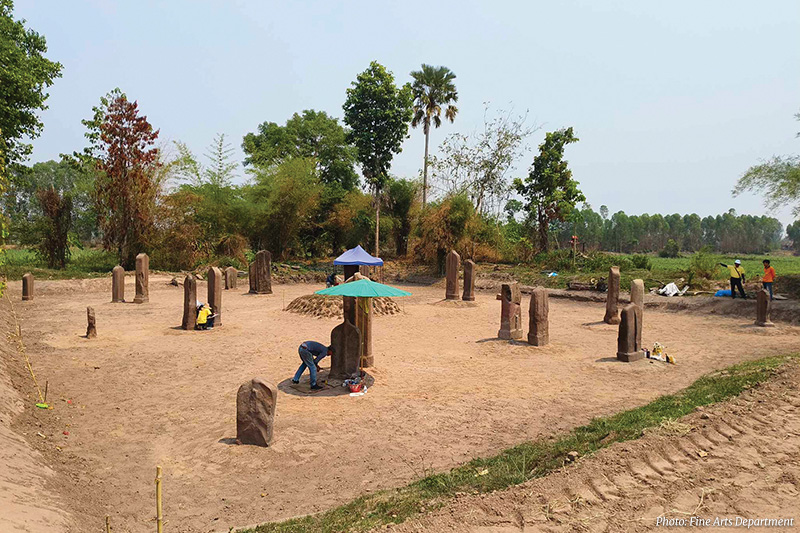
Lost in Time and Myth at Phu Phra Bat
At Thailand’s newest UNESCO World Heritage Site, every boulder tells a story
Words: Phoowadon Duangmee
Photos: Fine Arts Department and Shutterstock
Hidden in the remote forests of Udon Thani province, Phu Phra Bat Historical Park is Thailand’s newest UNESCO World Heritage Site – a magical landscape where history, mythology, and nature intermingle. Here, bizarre rock formations rise like ancient fortresses, protecting prehistoric paintings, ancient Buddhist artefacts and legends of yesteryear. Far from the country’s popular beaches and bustling cities, Phu Phra Bat offers a journey into the unknown, where every boulder and tree tells a story.
Carved over millions of years by the forces of wind and water, Phu Phra Bat’s rocky terrain is a geological wonder. Massive boulders balance improbably on slender stone pillars, while vast rock shelters house shrines dating back a thousand years and more. These rock formations are the result of natural erosion, but local folklore points to a mystical origin. According to legend, the gods themselves sculpted these stones to serve as markers of history and devotion.
The serene and otherworldly forest of Phu Phra Bat also makes a fantastic landscape for trekking. Walk in the footsteps of folk who lived here a thousand years ago and immerse yourself in an unforgettable journey through space and time.
Beyond its surreal landscape, Phu Phra Bat also holds keys to unlock Thailand’s deep Buddhist heritage.
Scattered across the park are ancient Sima stones – boundary markers used for Buddhist ordination halls – dating back to the Dvaravati period (6th – 11th centuries). Unlike the markers found at Buddhist temples today, these stones stand tall amid the rock-hued shrinese, their surfaces etched with lotuses and inscriptions.
At Wat Phor Ta (Temple of the Father-in-Law), two concentric rings of Sima stones guard a sixth-century Buddha statue. This ancient fusion of the natural and religious worlds is what gives Phu Phra Bat a unique atmosphere, setting it apart from other sacred sites in Southeast Asia.
Further into the park, an unassuming stone slab bears a distinctive indentation – said to be the footprint of Shakyamuni Buddha himself. Legend has it that the Buddha visited these hills and left his divine mark as a guide to pilgrims. The fame of this relic, now part of Wat Phra Phutthabat Bua Ban, has drawn worshippers from across the region for centuries. Whether you’re a believe or just an explorer, standing before this sacred imprint evokes a sense of wonder – an invitation to contemplate the mysteries of faith and time.
Phu Phra Bat was inscribed as a UNESCO World Heritage Site in July last year, confirming its cultural and historical value. This recognition not only brings global attention but also ensures its preservation for future generations. Thanks to the efforts of Thailand’s Fine Arts Department and forestry officials, the site remains remarkably well-preserved, with lush forests enhancing its untouched beauty.

However, the deeper you go, the more surreal the surroundings become.
Rock formations resembling giant mushrooms, looming towers, and precariously balanced boulders create a dreamlike landscape. Among the most famous formations are Hermit Cave and Son-in-Law Teample, each rich with its own mythological significance and captivating tales.
But the most spectacular of all is Hor Nang Usa rock chamber.
Enriched by ancient stone boundary markers, Hor Nang Usa is a jaw-dropping monument to the passage of time – a towering rock pillar capped by a flat boulder to create the effect of a giant mushroom. Rising 10 metres from a broad stone plateau, the pillar is topped by the “mushroom’s head”, which spans 5 metres by 7 metres.
While nature sculpted its dramatic silhouette, archaeologists believe prehistoric inhabitants may have repurposed the rock as a shelter. Evidence suggests the space beneath the capping boulder was divided into chambers, with stone-carved openings resembling windows for a refuge – or perhaps a sacred site.
Local legend tells of Nang Usa, a princess whose beauty was said to rival that of the goddesses. Fearing that she might fall in love with an unworthy man, her father, the king, confined her within the towering rock chamber. Yet, a charming prince discovered her in prison and won her heart. She escaped, defying her father’s will – but also fulfilling his deepest fear. The prince already had a wife back home, along with a harem of unkind consorts. While their romance may have ended badly, Hor Nang Usa stands as a reminder that love will always find a way. Step closer to the rock tower and you can almost hear the echoes of whispered meetings and stolen glances.

Wandering through Phu Phra Bat Historical Park, you can’t help feeling lost in time – history, myth and reality intermingling in its many coexisting worlds.
Long before the legend of Nang Usa, prehistoric communities left their mark on Phu Phra Bat. Prehistoric paintings dating back over 3,000 years adorn the rock shelters, depicting human figures, wild animals, and enigmatic patterns. Archaeologists believe they served a ritual purpose. The most captivating of these ancient murals can be found at Tham Wua (Cow Cave), where paintings of cattle hint that people may have farmed here three millennia ago.
Phu Phra Bat Historical Park offers far more than ancient ruins. From the dawn of civilisation to the golden age of Buddhism, from lush woodland to geological wonders, this place echoes with the mystical passage of time.
For those seeking an alternative to Thailand’s busy cities, luxury resorts and gilded temples, Phu Phra Bat offers something entirely different – a journey of discovery. Whether you come for the legends, the prehistoric art, or the raw natural beauty, you’ll leave with a feeling of having unearthed one of Thailand’s most fascinating hidden treasures.
Travel Information
Phu Phra Bat Historical Park is located in Ban Phue District, Udon Thani province, 80 kilometres north of Udon Thani town. Travellers can take a bus from Udon Thani Bus Terminal to Ban Phue, then hire a local taxi or songthaew (shared pickup-truck taxi) to the park. The park is open daily from 8.30am to 4.30pm.
